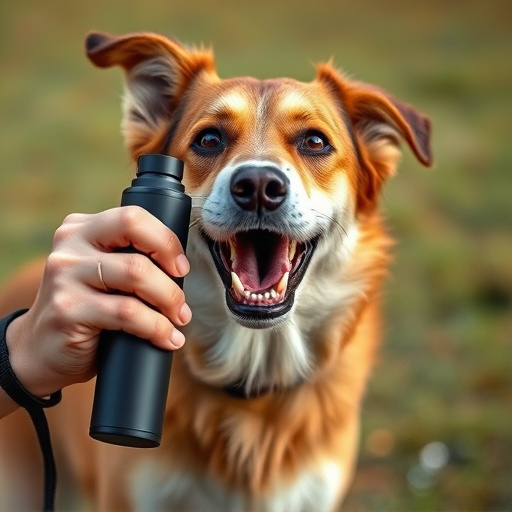Dog repellent sprays, available in aerosols and liquid concentrates, use ingredients like capsaicin and synthetic pheromones to deter dogs. Local regulations vary widely; understanding these is crucial for legal and responsible use. Selection should consider active ingredients, safety, and specific needs (garden protection, area deterrence, or managing aggressive dogs). The best way to store dog repellent spray is in cool, dry places out of reach from children and pets to maintain potency and safety. Effective application targets sensory points, uses strategic boundaries, maintains regular applications, and stores safely. Responsible disposal methods involve keeping them away from children and pets, maintaining original packaging, and adhering to local guidelines to prevent environmental contamination.
Animal control sprays have emerged as a popular method for managing wildlife and domestic animal interactions. This comprehensive guide explores the legal use of these repellents, focusing on dog repellent sprays. We delve into the various types available, their underlying mechanisms, and the intricate legal framework surrounding their application. Understanding these aspects is crucial for responsible and effective use. Additionally, we provide practical tips on selection, application, storage, and disposal, ensuring you have the best way to store dog repellent spray while maintaining safety and legality.
- Understanding Animal Control Sprays: Types and Legal Framework
- Choosing the Best Dog Repellent Spray: Factors to Consider
- Safe and Legal Application Methods for Effective Results
- Storage and Disposal Guidelines for Dog Repellent Sprays
Understanding Animal Control Sprays: Types and Legal Framework
Animal control sprays, also known as dog repellent sprays, are designed to deter and manage problematic animal behavior, particularly from dogs. These products come in various forms, including aerosols, liquid concentrates, and ready-to-use solutions, each offering different application methods and levels of effectiveness. The active ingredients differ as well, with capsaicin (derived from chili peppers), synthetic analogs of natural dog pheromones, and other plant-based extracts being common choices.
The legal framework surrounding animal control sprays varies significantly by region. In many places, these products are readily available for over-the-counter purchase and can be used responsibly by homeowners and businesses to protect their property from unwanted canine intrusions. However, certain areas have implemented restrictions or even bans on specific active ingredients or types of spray, often due to concerns about animal welfare or environmental impact. For instance, some regions prohibit the use of sprays containing certain chemicals known to cause respiratory distress in animals. Therefore, understanding local regulations is crucial before considering any dog repellent spray as the best way to store and protect your property from unwanted canine visitors.
Choosing the Best Dog Repellent Spray: Factors to Consider
When selecting a dog repellent spray, several factors come into play to ensure its effectiveness and safety. One of the primary considerations is understanding your specific need. Different situations call for distinct approaches; whether it’s keeping dogs away from a garden, deterring them from entering a particular area, or managing an aggressive dog, each case requires a tailored solution. For instance, a spray with a longer-lasting scent might be ideal for extensive outdoor spaces, while a fast-acting, non-repellent training aid could be better suited for behavioral issues.
Another crucial aspect is the active ingredient and its safety profile. Some repellents use natural substances like capsaicin (from chili peppers) or citronella oil, which are generally considered safer but may have varying levels of efficacy. Synthetic chemicals, while potentially more potent, require careful handling to avoid harm to pets, humans, and the environment. Always check local regulations regarding the use of such products and opt for brands that offer detailed instructions and safety guidelines. The best way to store dog repellent spray is in a cool, dry place, out of reach from children and pets, to maintain its potency and ensure a safe experience.
Safe and Legal Application Methods for Effective Results
When using animal control spray, such as dog repellents, it’s crucial to employ safe and legal application methods for optimal effectiveness. The best way to store and use dog repellent spray is by following local regulations and adhering to manufacturer guidelines. Start by identifying the specific issue you’re addressing—whether it’s stray dogs entering your yard or pets overrunning certain areas. Select a spray that targets the senses of smell and taste, as these are highly sensitive for canines.
Apply the spray at strategic locations, focusing on boundaries like fences or walls. Use it sparingly and evenly to avoid wastage. For best results, apply it regularly, especially after rainfall or when new scent trails emerge. Ensure you store dog repellent sprays out of reach of children and pets, in a cool, dry place. This not only keeps them safe but also maintains the potency of the spray over time.
Storage and Disposal Guidelines for Dog Repellent Sprays
Storing and disposing of dog repellent sprays properly is essential to ensure safety and environmental protection. The best way to store these products is in a cool, dry place, away from direct sunlight and heat sources. Keep them out of reach of children and pets to prevent accidental exposure. Store them in their original packaging with labels intact for easy identification of ingredients and instructions.
When it comes to disposal, follow local regulations regarding hazardous waste. Some regions may require you to take these sprays to designated drop-off locations or events where hazardous materials are collected responsibly. Never pour dog repellent sprays down the drain or into the garbage, as this can contaminate water sources and harm wildlife. It’s a responsible pet owner’s duty to handle these products with care throughout their lifecycle.
Animal control sprays, when used legally and responsibly, offer an effective solution for managing unwanted animal interactions. By understanding the types available, selecting the right product based on specific needs, and adhering to safe application methods and storage guidelines, such as properly storing the best way to store dog repellent spray, individuals can humanely deter animals without causing harm. This comprehensive approach ensures a peaceful coexistence with both pets and wildlife.
